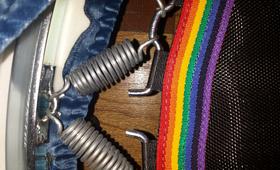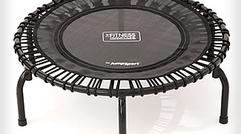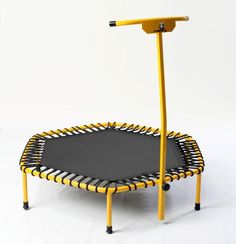The JumpSport is the latest in bungee band rebounding. The newest model, the 370 model, has far exceeded our expectations in bungees. Just like PacerMat revolutionized the rebounder in the 1980's. I stand by these next generation Jumpsport models, especially the 370 model.
The Fitness Trampoline, the next Generation in rebounding. They are shipped from the USA, either on the east or west coast, depending on which is cheaper or "who is not sold out first".
With this generation of bungee band rebounders, you do NOT have the option of trying to find a band that is suitable for your weight. The bands are adjustable. The only difference is the quality for longevity of the cords, not the tension. Now, the new cords on the 370 are finally available.
The bungee rebounder is especially recommended for individuals who suffer from severe back problems.
The footprint is about 42 inches in diameter because of the arched legs.
Let me interview you and get a free 30 day membership to Blindguru.com as on HealthyTrampolines.com with your rebounder purchase.
The frame and leg quality is commercial grade construction.
I was very impressed when I used the latest Jumpsport 370 rebounder. I could not believe that they figured out how to have 7 tension levels. I don't have to ask people their weight anymore to make they get the right cord with the right tension. They have a very unique elastic cord (EnduroLast) that is supposed to be 12x better than standard cord designs. In 2010 the Flexbounce was one of the best sellers and now the FlexBounce is just, well, I won't say overkill, but something rated at 6 million cycles is just ridiculous.
I no longer have to offer a second set of bungee cords. I will just say that.
The rebounder is also 18 pounds. Very easy to carry around, even with its 15 gauge steel frame. The new mats are also made of Permatron which is the most expensive mat, not canvas. The frame is chrome plated and is rated at 11.75 inches high. You get very deep, gentle bounces with this. The legs are also arched so the legs don't tip causing warpage to the frame over time. This can handle weights up to 250 pounds. The frame is also 39 inches in diameter.
The latest 370 model for has 7 tension levels. Many people need to start out with something soft and as their density increases over usage, they can adjust it to become more firm. A lighter person might need to have the tension set on a lower setting to get the Health Bounce while a person around 250 pounds might have to set it the level 7 to get the Health Bounce. This is a really nice invention in bungee band rebounders. An improvement from having to choose a one strength bungee band and hoping it has the right tension before you buy it.
Most people call back and get the bar. You get more out of your workout with the bar. It is NOT just for balance.
I recommend this rebounder for:
Those who want a silent rebounder. (unless you sweat a lot on the cords, they are silent)
Those who can't sit still while watching TV or on the phone.
Headache prone individuals (this has the least ballistic impact of all rebounders, just make sure it's not too soft. You do need "some" resistance for lymphatic movement. Go for the firmer bungees so you don't just bounce without resistance.
Those who want a silent rebounder. (unless you sweat a lot on the cords, they are silent)
Those who can't sit still while watching TV or on the phone.
Headache prone individuals (this has the least ballistic impact of all rebounders, just make sure it's not too soft. You do need "some" resistance for lymphatic movement. Go for the firmer adjustable settings if your weight requires more resistance.
The smallest bungee is the best bungee is the one that I have tested that is the best for solving the problems of inversion and pronation. If you want bungee quality bounce with the right amount of g force, I have heard nothing but happy stories with people who bought the extra strong bands.
I won't go into the Health Bounce but if you are very light weight, 130 and under or are above 180, at 180 and up the efficiency rating goes down significantly. If you are 180 and think its hard to get 3 g forces with even close to as many bounces you can get on an original Health Bounce rebounder from the original designer, which sets the bar for the Health Bounce, try holding a 30 pound weight and see how many bounces you get in order to find that 3 g force. The more someone weighs, the higher they have to jump to get that. The acceleration and deceleration is just as good as the energy you are willing to put into it. You do get more "free" bounces with the bungee than any other spring model. Momentum and force is stored in the bungees even if you stop trying to bounce. A spring rebounder can stop you in a fraction of these bounces. The 3 g force range is iffy.
With the new adjustable cords, you can adjust the cords and take a stopwatch to see how many bounces you get per minute doing the Health Bounce. This is how you can find the right tension that is appropriate for your weight and not just guess. Similar to how a triple tiered spring adjusts to your weight, finally someone figured out how to do it with a bungee. By adjusting the tension you can customize the sweet spot in the mat and the tension around the edges. This way you can tweak the rebounder so you don't spend too much time being airborne and more getting the G forces from the mat. Whoever put this rebounder concept together is in highly in touch with the rebounding community. The company that makes these also is the largest trampoline manufacturer in the world so go figure.
Also, choosing a smaller mat or a very large mat plays a role. The smaller the mat, the less "coning" or inversion of the ankles but there are pros and cons of having a very large and a very small mat. To get the Health Bounce, the smallest size is probably preferred without knowing your weight class.
Compare the top Lymphatic Rebounders
New Zealand Lymphaciser VS CELLERCISER VS JUMPSPORT
FREE BONUS PAGE
The most important page on this site
The WRONG WAY to do the lymphatic Health Bounce
Go to Health Bounce Page
#1 Rule of Rebounding
for lymphatic rebounding
Always land on heels and roll to toe.
This can only be done with a minimal initial tension based on your weight.
Call 1-877-354-3778 for help choosing a rebounder.
...because not all rebounders are designed for detox and lymph drainage
We're Open Now
1-877-354-3778
Ask for Alex
LymphaticRebounding.com
LYMPHACISER
NEEDAK
CELLERCISER
REBOUNDAIR
JUMPSPORT
BELLICON
LYMPHOLINE
HEXAGONAL
BUNGEE
The newest
bungee rebounder.
We're Open Now
1-877-354-3778
Ask for Beth
1. Are your ankles weak, and do you possibly have trouble with pronation (cocking-inward)?
Takes just a couple of minutes!
This quiz will isolate all rebound-relavent issues and leave your contact information with the best time to call.
I will contact you personally and help you find the best deal on your new rebounder.
Better health and well-being are closer at hand than ever!
2. Are your knees weak?
3. Do you have any balance problems?
4. Are you concerned with your weight?
5. Do you suffer from back pain?
6. Are you sensitive to chemical and plastic leaching (vapors from synthetic materials)?
7. Are you interested in rebounding to improve your health (lymph workouts) or do the Health Bounce?
8. Are you interested in rebounding as a low-effort form of fat burning or cardio exercise?
9. How much do you weigh?
10. Is noise level an issue where you plan to rebound?
11. If you're going to sweat a lot on the rebounder, how do you prefer to clean it?
12. Which grade of rebounder do you want?
13. Which rebounder brand are you most interested in?
Your Name
Your Email
Your Number
comments/questions/feedback
Is there anything I need to add or change on this site
Time Zone
Best time to call
If other, which one
Take the Rebounding Quiz Below





















